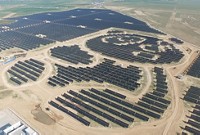Advertisement
Grab your lab coat. Let's get started
Welcome!
Welcome!
Create an account below to get 6 C&EN articles per month, receive newsletters and more - all free.
It seems this is your first time logging in online. Please enter the following information to continue.
As an ACS member you automatically get access to this site. All we need is few more details to create your reading experience.
Not you? Sign in with a different account.
Not you? Sign in with a different account.
ERROR 1
ERROR 1
ERROR 2
ERROR 2
ERROR 2
ERROR 2
ERROR 2
Password and Confirm password must match.
If you have an ACS member number, please enter it here so we can link this account to your membership. (optional)
ERROR 2
ACS values your privacy. By submitting your information, you are gaining access to C&EN and subscribing to our weekly newsletter. We use the information you provide to make your reading experience better, and we will never sell your data to third party members.
Business
Walmart Turns To Thin-Film Solar
Renewable Energy: Project will give Miasolé and First Solar a rooftop tryout
by Melody Voith
September 27, 2010
| A version of this story appeared in
Volume 88, Issue 39

Walmart will add thin-film technologies to its program for building rooftop solar systems on its stores. The move boosts prospects for thin-film manufacturers as they struggle to win market share from crystalline silicon solar firms.
The megaretailer will work with solar project developer SolarCity, which will design, install, own, and maintain the new solar power systems. SolarCity will install copper indium gallium selenide (CIGS) and cadmium telluride solar modules at 20 to 30 sites in California and Arizona.
According to Walmart, the project will generate 22.5 million kWh of energy per year, enough to supply 20 to 30% of total energy needs at each location. The company says its goal is to obtain 100% of its energy from renewable sources.
“By leveraging our global scale to become a more efficient company, we are able to lower our expenses and help develop markets for new technologies,” says Kim Saylors-Laster, Walmart’s vice president for energy. The company says it obtained financing for the project from National Bank of Arizona and the utility PG&E and incentives from two government programs. The Environmental Defense Fund, an environmental group, helped Walmart choose the technologies.
SolarCity will purchase CIGS modules from start-up Miasolé and cadmium telluride modules from thin-film leader First Solar. The efficiency of CIGS solar modules, in the range of 10.5 to 13%, is competitive with traditional crystalline silicon cells. But CIGS firms have been floundering as cheap, Chinese-made crystalline silicon modules flood the market, according to Jason Eckstein, solar analyst at Lux Research. Crystalline silicon has 75% of the world market for all solar technologies, he says. Cadmium telluride technology, primarily from First Solar, claims 12% of the market, and CIGS has only a 1 to 2% share.
Walmart’s interest in new solar technology “gives a huge vote of confidence for CIGS,” Eckstein says. “This really is a feather in Miasolé’s cap to have such a high-profile customer. And it’s an opportunity for SolarCity to evaluate if they want to use CIGS in future installations.”



Join the conversation
Contact the reporter
Submit a Letter to the Editor for publication
Engage with us on Twitter